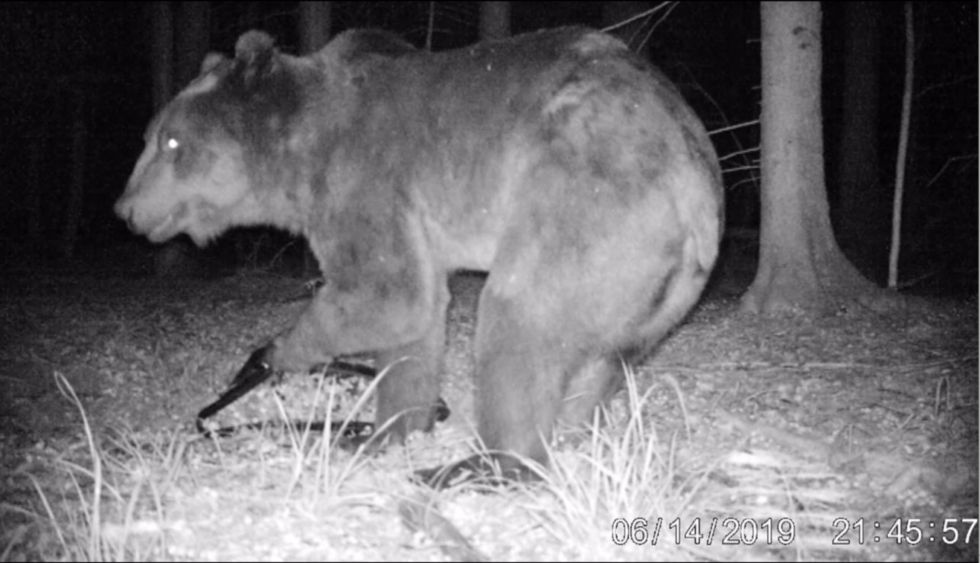By Tom Diserens
Białowieża Forest is Europe’s last primeval forest. The vast expanse of dense woodland on the border between Poland and Belarus is replete with moss-covered trees harbouring species extinct elsewhere. Yet, for all its well-preserved nature, and successful efforts to reintroduce its iconic bison, since the Second World War the forest had been missing its largest carnivore − the bear.
Since its disappearance in 1947, people have speculated about the bear’s possible return to Białowieża. Several ideas were considered, including reintroduction, or natural recolonisation from refuges in eastern Belarus, where the species still survives. But as decades passed with no signs of bears, hope was slowly abandoned.
Few people, therefore, could have expected what happened on 17 June 2019.
The day the bear showed up
On a pleasant June afternoon, I had just finished zig-zagging between my experimental plots scattered around the remote areas of the forest. When my phone signal returned, the screen lit up with a flurry of missed calls and a text message from my colleague: “We recorded a bear!”
A camera trap put up in the forest to film badgers had caught sight of a wandering bear. I raced back to the Mammal Research Institute to see the recording. We published the video that same afternoon, and soon after word spread like wildfire.
By the evening it had been broadcast on national television, shared thousands of times online, and chronicled across several news articles. It dawned on me that this was a historic moment: we were witnessing the latest chapter in the bear’s epic history in Białowieża Forest.
Amid the excitement, my colleagues and I began asking some important questions. Would bears soon permanently recolonise the forest? What effect would this have on the forest’s ecosystems and local human society? In our quest to find the answers, we learned that the story of the bear in Białowieża Forest is perhaps one of the most unusual of all species anywhere, and closely intertwined with Poland’s own dramatic history.
The history of Białowieża’s bears
From the 14th century till the late 1700s, Białowieża Forest served as a private hunting ground for Polish-Lithuanian kings. The bear, alongside the European bison, was one of the most valuable big game species reserved for royal hunts.
The forest and its animals were strictly protected: settling, logging and hunting were forbidden. The sporting royals had created one of the world’s earliest conservation programmes. The system was maintained for centuries, until the forest was annexed by Imperial Russia in 1795.
The woodland’s new administration changed strategy. While the bison was still to be protected, the bear was recast as a pest to be exterminated. The bear population consequently dwindled, until the last of its species was killed in 1879, marking its first extinction from Białowieża Forest.
The First World War ushered in the most tumultuous period in the forest’s history. The German occupiers disregarded almost all traditional protection measures and cut down a fifth of the forest in just three years. The devastation culminated with the last wild-living European bison being killed in 1921.
When Poland regained its independence in 1918 and took back administration of the area, it rewrote the woodland’s laws once again. The forest’s ancient trees were now to be logged – a profoundly damaging tradition that has continued to the present day – while its animals were to be protected.
Bold plans for the reintroduction of both the European bison and bear were swiftly drawn up. This time, however, the motive was conservation, not hunting. Bringing back the bear was to be the world’s first large carnivore reintroduction, and an early precursor to modern rewilding movements.
The promising reintroduction of bears started in 1938 was stymied by the outbreak of the Second World War. Each of the subsequent occupiers came with methods of their own.
First, the Soviets, who occupied the region for two years from 1939, released a tame female bear used for breeding in the reintroduction programme. After 1941, the Germans then released five completely tame bears into the forest. However, the new assortment of tame bears came into conflict with local people, who killed them in response.
After the war, Białowieża Forest was divided by the Polish-Belarusian border, and for some years bears could still be spotted on either side of the border. By 1947, however, the population again dwindled to extinction.
While many bears still survived in central European highlands, they did not return to the lowlands. Barriers such as fenced highways and extensive deforested areas prevent them from dispersing from the Polish mountains. Scientists have concluded that the only passage for the species would be via forested corridors from Belarus, where a small population has survived.
Since the mid-2000s, bears have been expanding out of their eastern Belarusian refuges. They have now recolonised Naliboki Forest – a 1,500 square km boreal semi-wilderness near Minsk – just 200 kilometres away from the Polish border, a distance easily traversed by a dispersing bear. This is where we think the recent visitor to Białowieża Forest came from.

A bear was again spotted on 1 April 2020 on the Belarusian side of the forest (photo: Aleksandr Pekach)
Transforming Białowieża Forest’s ecosystem
Many wild species, such as wolves, transform ecosystems when reintroduced. Less well known, however, is the remarkable ecological role played by bears.
The main way in which bears shape ecosystems is through what they eat. Bears are omnivores, and they can consume almost anything they can get their paws on, with the lucky exception of humans. That includes grasses, herbs, roots, berries, nuts, but also animal matter such as insects, mammals, and fish.
Bears can eat over 100,000 berries per hour, which makes them the dominant seed dispersers of some plant species. Moreover, the mere presence of bears can cause prey species to change their behaviour to avoid being eaten by the newcomers (known as the “landscape of fear” effect). This redistribution of herbivores in the forest can cascade down the food chain, affecting plant regeneration.
Bears are notable scavengers, who often steal the kills of their competitors − species like the wolf and lynx. This can force these carnivores to kill more prey to compensate for the lost food, thus increasing their regulatory effect on herbivore populations.
Finally, bears are ecological engineers – that is, they create habitats for other species. They damage trees by stripping their bark during foraging, marking and body care, thereby creating habitat for wood-boring insects, woodpeckers, small mammals, amphibians and fungi.
The restoration of these ecological interactions restores the health of an ecosystem by making it more resilient. For Białowieża Forest this is especially important. The forest is already one of the only places in Europe where we can study nature that has not been completely transformed by mankind.
What next for the bears?
With the bear strictly protected within both EU and Polish law, any bears crossing the Polish-Belarusian border gain automatic, strict legal protection.
However, no species restoration can be successful without the consent of local communities. A big concern at the moment is about how to avoid potential conflicts between bears and humans. Lowland central Europeans who have not lived alongside bears for over 70 years will have to get used to their new neighbours.
Moreover, the bear is one of the most targeted species for wildlife tourism. The borderlands between Poland and Belarus, and in particular Białowieża Forest, are prime tourist destinations. As a first step, my colleagues have already issued a poster to inform people how to behave if they meet a bear.
Bears pose little direct danger to humans. They can, however, steal honey, livestock and fruit, and often raid bins. People will need to learn to protect their belongings, and the authorities will need to introduce support networks and compensation schemes.
It is also crucial that people do not provide bears with food, let alone feed them, as this habituates them to human contact and disrupts their natural behaviour. Ultimately, a bear emergency team will need to be on permanent standby, ready to intervene in case a seriously problematic bear appears.
Bears and their signs continue to be spotted in the forest. In April 2020, a bear was again caught by a camera trap on the Belarusian side of the forest. In September tourists photographed bear tracks on the Polish side. A few days later, another group of tourists directly observed a bear in a different part of the forest. But we have no idea whether these are all of the same individual, or several; only genetic studies will answer that question.
While it is perhaps too early to talk of a restored population – for that we will need evidence of a female with cubs – the future is nonetheless looking good for bears. The bear population in Naliboki Forest continues to expand, and so we await further bears to disperse across the border.
A new era in Europe’s last primeval forest may be just around the corner.
Main image credit: Tom Diserens & Mammal Research Institute PAS





















